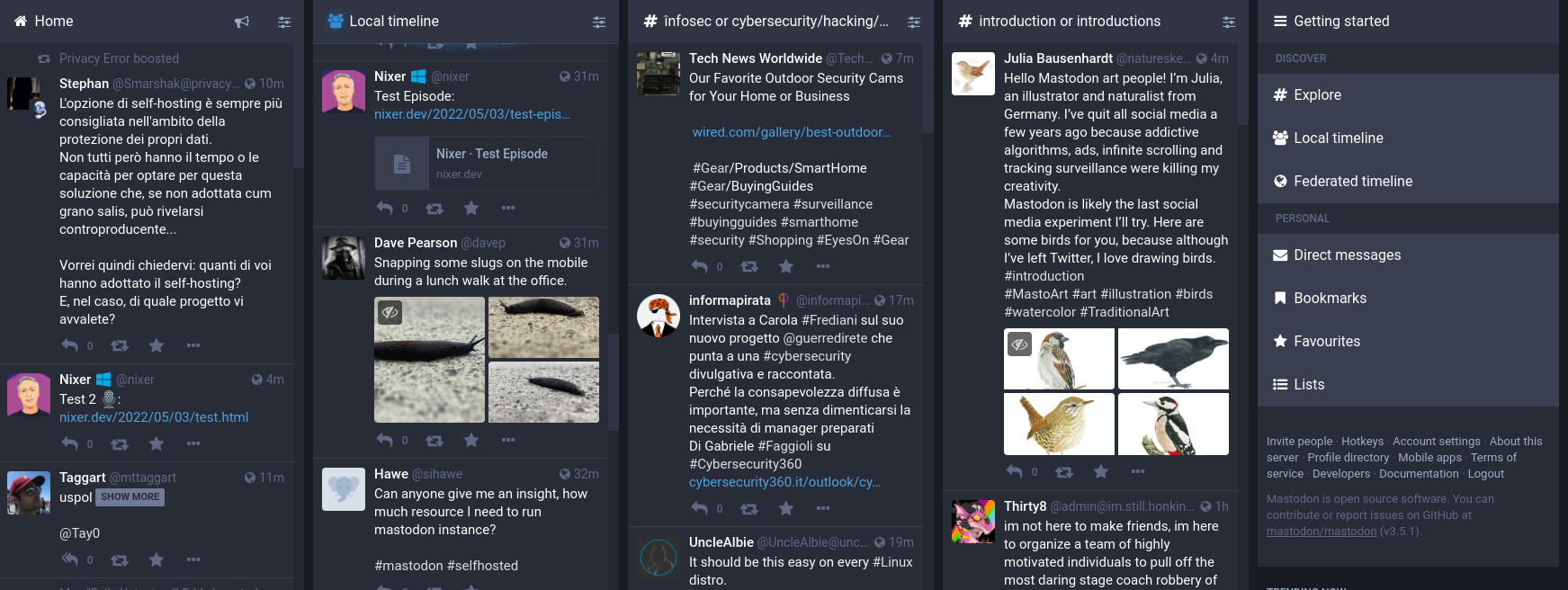Look, it's not original thinking to be concerned about the future of social media with a megalomaniacal billionaire threatening to impose regressive policies. Enough ink has already been spilled on what might or might not happen with Twitter as the new owner molds it in his image. The debate rages on about whether Twitter is a town square, whether it ought to be, or whether something that functions as a public service should in fact be driven by profit. But that debate misses the fact that some folks have already created a truly free alternative. It didn't require government intervention. As always in the open source software world, it simply took the conviction, creativity, and hard work of a community.
Or in this case, a federation of communities. This last week, I dove back into the Fediverse by way of Mastodon. Mastodon is a free and open alternative to Twitter—or "the birdsite," as users of Mastodon call it. What I've found has not just made me want to stay, but made me question my assumptions about social media in general.
Let's explore how your entry into the Fediverse might proceed.
Day 1: Toes in the Water
So you're a Twitter user, and you largely enjoy your time there. Sure, sometimes it's toxic and you know it takes more of your attention than it should, but you've made what feel like real connections with people. Hell, maybe it's even been professionally important to you. Networking is networking, right? And who can deny the value of the technical information to be found, especially in the security and programming fields.
But you worry that the future of the platform looks brighter for trolls and Nazis than it does for useful discourse. And as much as you value the connections you've made, something about supporting a platform that could very well destabilize a democracy feels wrong at an instinctive level. You know the open source crowd is always creating funky alternatives to mainstream platforms; maybe they have something worth checking out here.
You hear about this thing—not a place, really, not any one site, but a...collective. An idea? It's called the Fediverse, a collection of social networking sites linked together through a protocol called ActivityPub. Many servers, many communities, all connected and sharing as people please. Anyone can make a new server, but many already exist, focusing on a wide array of interests.
As an existing Twitter user, you find yourself looking for a Mastodon server. Mastodon looks like Twitter, but in the resemblance is largely superficial.
You find a server. Maybe it's the largest one, mastodon.social. Or maybe you seek creative folks on mastodon.art. Or perhaps, like me, you find your open source compatriots at fosstadon.
Ultimately whatever server you choose doesn't limit your Fediverse experience, but it will shape the first people you encounter.
You'll likely want to download an app to your phone. The official app is fine, although if you're an Android user, Tusky might be worth a look. Toot! on iOS is popular as well.
With your account setup, you leave the deep exploration of Mastodon for tomorrow.
Day 2: Seeking Your Fediverse
It starts out quiet. That's because no algorithm is feeding you recommended content. It's up to you to find people to follow on your own. If your home server is full of people you find interesting, you can explore the Local Timeline for a bit to see what's up and find folks you enjoy there. Alternatively, you might jumpstart your feeds with follows recommended by Trunk.
The advanced web interface allows easy pinning of searches for hashtags and columns for the Home (your follows) and the local timeline (folks on your home server). Realizing this power, you pin a search for introductions to your page and watch all the new folks come into the Fediverse.

You may find yourself seeing languages besides your own. How exciting that this social network exposes you to the thoughts of people from around the world, and doesn't spoon-feed you exactly what it wants you to see!
You create another pinned column or two that follows hashtags that interest you. You can track more than one hashtag per column—very helpful for tracking a topic that uses multiple terms.
It's time to write your own introduction. The first thing you notice is the character limit: 500! Quite a bit of space to express yourself. The new post toot interface also has visibility controls for whether the toot should be visible to everyone, everyone but not shown in public timelines, followers only, or direct to a specific user. For an introduction, public is best.
On the matter of direct messages, you remember your pal Taggart warning you that Mastodon server admins can, if they need to, read your DMs. They shouldn't be considered private in that sense. For sensitive conversations, another communication medium would be best.
There's also a button whose meaning isn't immediately clear. CW? What's that? Clicking on it adds a small text field above your toot itself. This is the Content Warning label, and you can use it to optionally hide the body of your toot so folks can choose to see potentially unwanted content. Looking around the local and Home timelines, you get a feel for how the Fediverse uses content warnings. It's nice, you think, to be able to choose to see some of this for oneself.
You complete the introductions post, making sure to add hashtags for your areas of interest. You hit Toot!, giggling to yourself about the goofy term. But then, was "tweet" any less silly?
Soon, your notifications column is lighting up with favorites and boosts. That's when you realize that none of the posts you're seeing on the timeline display their engagement metrics. Unless you click on a post, there's no way to tell at a glance how many people have favorited/boosted a post.
And it dawns on you: how freeing to just read, without worrying about how many people liked a thing. I can decide for myself. Nobody will be shown toots because someone favorited them. And I won't be tracking my own engagement stats either. They don't matter. They never did.
Day 3: Settling In
The next morning, you find not just faves/boosts of your into (and a few other posts you made as well), but replies! They're thoughtful. Well-written. The real-human-engagement/meme ratio here is totally different from what you're used to. It's exciting. You quickly start following these new connections and begin conversations with others in your timeline. All the while, the #introductions column continues to flow, showing you new people from all walks of life who have found this place just like you have.
It feels...connected. It feels human. Actually, you know what it feels like?
It feels like the internet we hoped for. Reaching out across a digital space and finding humans on the other side. But without ads getting in the way, and without some algorithm deciding what you should see.
Is it perfect? By no means. What social network is? But you feel that maybe, just maybe, what it lacks in refinement or ease of receiving content, it more than makes up for in sanity and quality of human connection.
Will you completely depart Twitter the birdsite? Maybe, maybe not. You don't have to choose. But at the very least, you're enjoying your time in the Fediverse, and you can see the idealism of its proponents rubbing off on you.
And you wonder, closing the app for the day, what a little more idealism turned into action would look like.
